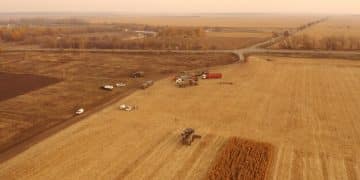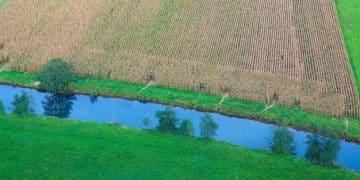US Farm Bill: How Government Subsidies Impact Crop Production

The US Farm Bill significantly shapes crop production through government subsidies, influencing farmers’ decisions on what and how much to plant, impacting market dynamics across the agricultural sector.
The agricultural landscape in the United States is deeply intertwined with government support, primarily through subsidies outlined in the Farm Bill. Understanding how the new Farm Bill impacts **US Government Subsidies: How Will the New Farm Bill Affect Crop Production Decisions?** is crucial for farmers, policymakers, and consumers alike.
Understanding the US Farm Bill and Its Significance
The US Farm Bill is a comprehensive piece of legislation that has a profound impact on agriculture in the United States. It’s not just about farming; it touches upon various aspects of the food system, from nutrition to conservation. Understanding its key components is vital for anyone involved or interested in agriculture.
What is the Farm Bill?
The Farm Bill is a package of legislation passed every few years that has a wide-ranging impact on American agriculture. It covers everything from commodity programs and conservation efforts to nutrition assistance and rural development. The bill is typically reauthorized every five years, providing a framework for agricultural policy.
Key Components of the Farm Bill
The Farm Bill is divided into several titles, each addressing a specific area of agriculture and related fields. Key titles include Commodity Programs, Conservation, Nutrition (including SNAP), Trade, Rural Development, Research, Forestry, Energy, Horticulture, and Crop Insurance. These titles work together to shape the agricultural landscape.
- Commodity Programs: Provide financial support to farmers for specific crops, helping to stabilize income.
- Conservation: Support farmers in implementing environmentally friendly practices.
- Nutrition: Fund programs like SNAP (Supplemental Nutrition Assistance Program) to combat food insecurity.
- Crop Insurance: Offer protection against losses due to natural disasters or market fluctuations.
The Farm Bill is a critical tool for shaping agricultural policy and supporting the livelihoods of farmers across the country. It addresses challenges such as food security, environmental sustainability, and economic stability in rural communities.

How Government Subsidies Influence Crop Choices
Government subsidies play a significant role in influencing what farmers choose to plant. These financial incentives can shift the balance of profitability, leading to certain crops being favored over others. Understanding this dynamic is key to understanding agricultural production patterns.
Direct Payments and Their Effects
Direct payments, a type of government subsidy, can have a substantial impact on farmers’ planting decisions. By providing a guaranteed income stream, these payments can encourage farmers to grow crops regardless of market demand. This can lead to overproduction and market imbalances.
Crop Insurance and Risk Management
Crop insurance programs, another form of government support, can also influence crop choices. By reducing the financial risk associated with crop failure, insurance can encourage farmers to plant crops that might otherwise be considered too risky. This can promote diversification but also lead to increased production of certain crops.
Market Distortions and Unintended Consequences
Government subsidies can create market distortions by artificially inflating the profitability of certain crops. This can lead to overproduction, lower prices, and reduced competitiveness for other crops. These unintended consequences can have a ripple effect throughout the agricultural sector.
- Overproduction: Subsidies can lead to an excess supply of certain crops.
- Lower Prices: Increased supply can drive down market prices, affecting farmers’ profitability.
- Reduced Competitiveness: Some crops may become less competitive due to the artificial advantage of subsidized crops.
Government subsidies are a powerful tool that can shape crop production patterns. While they can provide stability and support for farmers, they can also create market distortions and unintended consequences that need careful consideration.
The Role of Conservation Programs in Shaping Production
Conservation programs are an integral part of the Farm Bill, promoting sustainable agricultural practices. These programs not only benefit the environment but also influence crop production decisions by incentivizing responsible land management.
Environmental Quality Incentives Program (EQIP)
The Environmental Quality Incentives Program (EQIP) provides financial and technical assistance to farmers who implement conservation practices on their land. This can include measures to reduce soil erosion, improve water quality, and enhance wildlife habitat. By participating in EQIP, farmers can receive payments that offset the cost of these practices.
Conservation Stewardship Program (CSP)
The Conservation Stewardship Program (CSP) rewards farmers who are already implementing conservation practices and encourages them to adopt additional ones. CSP provides payments for maintaining and enhancing existing conservation efforts, as well as for adopting new practices that further improve environmental outcomes.
Impact on Crop Production Decisions
Conservation programs can influence crop production decisions by encouraging farmers to adopt practices that enhance soil health and water quality. This can lead to increased yields, reduced input costs, and improved resilience to climate change. By integrating conservation into their farming operations, farmers can achieve both environmental and economic benefits.

- Increased Yields: Healthy soil leads to better crop productivity.
- Reduced Input Costs: Efficient resource use lowers expenses.
- Climate Resilience: Conservation practices enhance farm resilience to climate variability.
Conservation programs play a vital role in shaping sustainable agricultural practices. By providing financial and technical assistance, these programs incentivize farmers to adopt practices that benefit both the environment and their bottom line.
Analyzing the Potential Impacts of the New Farm Bill
Each new iteration of the Farm Bill brings with it the potential for significant changes in agricultural policy. Analyzing the potential impacts of the new bill is essential for understanding how it will affect crop production decisions, market dynamics, and the overall agricultural landscape.
Changes in Commodity Programs
Changes in commodity programs, such as modifications to direct payments or crop insurance, can have a direct impact on farmers’ planting decisions. Adjustments to payment rates, eligibility requirements, or covered crops can shift the balance of profitability, leading to shifts in production patterns.
Updates to Conservation Initiatives
Updates to conservation initiatives, such as increased funding for EQIP or CSP, can encourage greater adoption of sustainable agricultural practices. This can lead to reduced environmental impacts and improved long-term productivity. Changes to conservation programs can also influence the types of crops that are grown, as farmers may choose crops that are better suited to conservation practices.
Effects on Small and Mid-Sized Farms
The Farm Bill can have a disproportionate impact on small and mid-sized farms, which may be more reliant on government support than larger operations. Changes to commodity programs or conservation initiatives can affect the viability of these farms, influencing their ability to compete in the marketplace. Policies that support local food systems and direct-to-consumer sales can also play a crucial role in the success of small and mid-sized farms.
The new Farm Bill has the potential to reshape the agricultural landscape in significant ways. By analyzing the changes in commodity programs, conservation initiatives, and their effects on different types of farms, we can gain a better understanding of the bill’s potential impacts.
Case Studies: Farm Bill Effects on Specific Crops
Examining case studies of how the Farm Bill affects specific crops can provide valuable insights into the complexities of agricultural policy. These case studies can illustrate how subsidies, conservation programs, and other provisions of the bill influence production decisions and market outcomes.
Corn and the Ethanol Mandate
The Farm Bill, in conjunction with the Renewable Fuel Standard (RFS), has had a significant impact on corn production in the United States. The RFS mandates the use of biofuels, primarily ethanol, which is largely produced from corn. This has created a strong demand for corn, leading to increased acreage and higher prices. Government subsidies for corn production have further incentivized farmers to plant this crop.
Soybeans and Trade Policies
Soybeans are another major crop that is heavily influenced by the Farm Bill. Trade policies, such as agreements with other countries, can have a significant impact on soybean exports and prices. Government subsidies for soybean production can help to support farmers’ incomes, but they can also lead to overproduction and trade disputes.
Specialty Crops and Local Food Systems
Specialty crops, such as fruits, vegetables, and nuts, are often overlooked in discussions of the Farm Bill. However, the bill includes provisions that support specialty crop research, marketing, and promotion. These provisions can help to increase demand for specialty crops and support local food systems. Policies that encourage direct-to-consumer sales and farmers’ markets can also benefit specialty crop growers.
- Increased Demand: Ethanol mandates and trade agreements drive demand for specific crops.
- Price Stability: Subsidies provide a safety net for farmers, but can distort market prices.
- Support for Diversity: Policies can encourage the production of a wider variety of crops.
Case studies of specific crops can help to illustrate the complex interplay between the Farm Bill, market forces, and agricultural production decisions. By examining these examples, we can gain a better understanding of the challenges and opportunities facing American agriculture.
Strategies for Adapting to the New Farm Bill
As the agricultural landscape evolves, farmers need to be proactive in adapting to the changing policy environment. Developing strategies for navigating the new Farm Bill is essential for ensuring long-term success and sustainability.
Diversification and Risk Management
Diversification can be a valuable strategy for managing risk in agriculture. By growing a variety of crops, farmers can reduce their reliance on any one commodity and mitigate the impact of market fluctuations. Crop insurance, conservation practices, and value-added enterprises can also help to diversify income streams and reduce risk.
Sustainable Farming Practices
Adopting sustainable farming practices can enhance long-term productivity and resilience. Conservation tillage, cover cropping, and integrated pest management can improve soil health, reduce input costs, and minimize environmental impacts. These practices can also make farms more competitive and adaptable to changing market conditions.
Farmers must stay informed and engaged in the policy process to advocate for their interests and shape the future of agriculture. Participating in farm organizations, attending public hearings, and communicating with policymakers can help to ensure that farmers’ voices are heard.
Adapting to the new Farm Bill requires a proactive and strategic approach. By diversifying operations, adopting sustainable practices, and staying engaged in the policy process, farmers can thrive in an ever-changing agricultural landscape.
| Key Point | Brief Description |
|---|---|
| 🚜 Farm Bill Overview | Legislation affecting US agriculture, reauthorized every 5 years. |
| 💰 Government Subsidies | Influence crop choices, potentially causing market distortions. |
| 🌱 Conservation Programs | Promote sustainable practices, enhancing soil health and water quality. |
| 🌾 Adaptation Strategies | Diversification, sustainable practices, and policy involvement. |
Frequently Asked Questions
▼
The main goal is to stabilize farm incomes, ensure a reliable food supply, and promote agricultural practices that benefit the environment and the economy.
▼
The US Farm Bill is typically updated every five years to adapt to changing agricultural needs and policy priorities.
▼
Subsidies can lead to overproduction, market distortions, and reduced competitiveness for non-subsidized crops, impacting market dynamics.
▼
They incentivize sustainable practices, improving soil health and water quality, which can lead to increased yields and reduced input costs.
▼
Diversification, adopting sustainable farming practices, and staying engaged in the policy process are key strategies for farmers.
Conclusion
The US Farm Bill and its provisions for government subsidies are pivotal in shaping crop production decisions across the nation. Understanding the intricacies of this legislation, its potential impacts, and strategies for adaptation is essential for farmers, policymakers, and anyone invested in the future of American agriculture.





